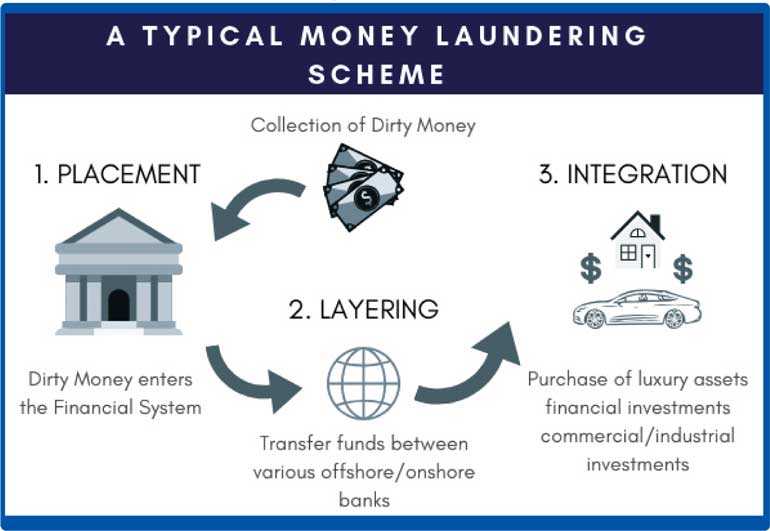Tuesday Apr 01, 2025
Tuesday Apr 01, 2025
Wednesday, 13 March 2019 00:00 - - {{hitsCtrl.values.hits}}

In light of Sri Lanka’s inclusion in the European Union’s (EU) list of high-risk countries for money laundering, and the subsequent rejection of this list by the European Council last week, this LKI Ex-plainer examines the key aspects of money laundering, the emerging challenges and its impact in Sri Lanka. It also explores vital domestic and international legal instruments in force to combat money laundering
By Nilupul Gunawardena and Shihan Maharoof
The EU blacklist of countries with deficient anti-money laundering (AML) and counter-terrorist fi-nancing (CTF) frameworks, which included Sri Lanka, was unanimously rejected by the European Council last week.1 The European Commission will now have to propose a new draft list of high-risk third countries that will address the concerns of the EU member states.
In 2018, the European Commission listed Sri Lanka as a country with deficient AML and CTF frame-works. Subject to a new methodology2 which reflected the stricter criteria of the 5th Anti-Money Laundering Directive (Directive (EU) 2018/843), the European Commission re-published their list in February 2019, including Sri Lanka as one of the 23 countries with strategic deficiencies in their anti-money laundering and terrorist financing regimes that pose significant threats to the financial sys-tem of the EU.3 While the rejection of the list may be of temporary relief to Sri Lanka, it certainly does not absolve Sri Lanka of the incumbent responsibility to strengthen its AML and CTF frame-works in compliance with international standards and requirements.
In light of these developments it is essential to understand the key aspects of money laundering and its implications for Sri Lanka as an emerging financial hub of the region.
1. What is money laundering?
2. How does money laundering impact society?
3. What are the problems in combating money laundering?
4. Some examples of the most high-profile money laundering cases
5. Combating money laundering in Sri Lanka
Prevention of Money Laundering Act No. 5 of 2006
The Financial Transaction Reporting Act No. 6 of 2006
The Convention on the Suppression of Terrorist Financing Act, No. 25 of 2005 (CSTFA)
5.1. Prevention of Money Laundering Act No. 5 of 2006
5.2 The Financial Transaction Reporting Act No. 6 of 2006
6. Why is it important for Sri Lanka?
7. What are the global initiatives and has Sri Lanka met the global standards?
identify the AML/CFT risks, and develop policies and strengthen domestic coordina-tion;
pursue money laundering and terrorism financing;
apply and ensure preventive measures for the financial sector and other designated sectors;
establish powers and responsibilities for the competent authorities (e.g., investiga-tive, law enforcement and supervisory authorities) and other institutional measures; and
enhance the transparency and availability of beneficial ownership information of le-gal persons and arrangements; and facilitate international cooperation.
8. Conclusion
9. Key readings
[Nilupul Gunawardena is a Research Fellow at the Lakshman Kadirgamar Institute of International Relations and Strategic Studies (LKI). Shihan Maharoof is a Research Assistant at LKI. The authors acknowledge with appreciation the editorial assistance and comments given by Joan Moonesinghe, former Director of Bank Supervision, Central Bank of Sri Lanka, and independent consultant on financial regulation, and the feedback given by C. A. H. M. Wijeratne, Additional Secretary (Legal) Ministry of Foreign Affairs. The opinions expressed in this article are the authors’ own views. They are not the institutional views of LKI, and do not necessarily represent or reflect the position of any other institution or individual with which the authors are affiliat-ed.]
Footnotes
1 The New York Times. (2019). EU Nations Reject Commission Money Laundering Blacklist. [online] Available at: https://www.nytimes.com/aponline/2019/03/07/world/europe/ap-eu-europe-money-laundering-.html [Accessed 8 Mar. 2019].
2 European Commission. (2019). Commission Staff Working Document. [online] Available at:
ttps://ec.europa.eu/info/sites/info/files/swd_2018_362_f1_staff_working_paper_en_v2_p1
_984066.pdf [Accessed 8 Mar. 2019].
3 European Commission. (2019). European Commission - PRESS RELEASES - Press release - European Commission adopts new list of third countries with weak anti-money laundering and terrorist fi-nancing regimes. [online] Available at: http://europa.eu/rapid/press-release_IP-19-781_en.htm [Ac-cessed 8 Mar. 2019].
4 United Nations Office on Drugs and Crime. (2018). Introduction to Money Laundering. [Online]. Available at: https://www.unodc.org/unodc/en/money-laundering/introduction.html?ref=menuside [Accessed 20 Nov 2018].
5 Ibid.
6 Ibid.
7 United Nations Office on Drugs and Crime. (2011). Estimating Illicit Financial Flows Resulting from Drug Trafficking and Other Transnational Organized Crimes. [Online]. Available at: https://www.unodc.org/documents/data-and-analysis/Studies/Illicit_financial_flows_2011_web.pdf [Accessed 22 Nov 2018].
8 TATA Consultancy Service Ltd. Anti-Money Laundering: Challenges and Threats. [Online]. Avialiable at: https://www.tcs.com/content/dam/tcs/pdf/Industries/Banking%20and%20Financial%20Services/Anti-Money%20Laundering%20-%20Challenges%20and%20trends.pdf [Accessed 22 Nov 2018].
9 Nations Office on Drugs and Crime. (2011). Estimating Illicit Financial Flows Resulting from Drug Trafficking and Other Transnational Organized Crimes. [Online]. Available at: https://www.unodc.org/documents/data-and-analysis/Studies/Illicit_financial_flows_2011_web.pdf [Accessed 22 Nov 2018].
10 Henning, P. (2015).The Challenges of Fighting Money Laundering. [Online] New York Times. Avail-able at: https://www.nytimes.com/2015/08/04/business/dealbook/the-challenges-of-fighting-money-laundering.html [Accessed 25 Nov 2018].
11 Hitt, J. (2000). The Billion-Dollar Shack. [Online] New York Times. Available at: https://www.nytimes.com/2000/12/10/magazine/the-billion-dollar-shack.html?pagewanted=1&_ga=2.240010763.942852779.1544106759-1673361091.1544106759 [Accessed 20 Nov 2018].
12 Whitehead, H. (2016). Top 5 Money Laundering Cases in the Last 30 Years. [Online] ICP. Available at: https://www.int-comp.com/ict-views/posts/2016/07/22/top-5-money-laundering-cases-of-the-last-30-years/ [Accessed 22 Nov 2018].
13 Fintechnews Singapore (2018). Asia’s Most Wanted Top Ten AML Cases. [Online]. Available at: http://fintechnews.sg/16105/fintech/asia-wanted-top-ten-aml-cases/[Accessed 10 Dec 2018].
14 ComplyAdvantage (2018). What is Anti-Money Laundering (AML) and Why is it Necessary? [Online]. Available at: https://complyadvantage.com/knowledgebase/anti-money-laundering/[Accessed 10 Dec 2018].
15 Parliament of the Democratic Socialist Republic of Sri Lanka (2006). Prevention of Money Launder-ing Act No. 5 of 2006. [Online]. Available at: http://www.oecd.org/site/adboecdanti-corruptioninitiative/39864395.pdf [Accessed 15 Dec 2018].
16 Ibid.
17 Parliament of the Democratic Socialist Republic of Sri Lanka. (2006). Financial Transactions Report-ing Act, No. 6 Of 2006. [Online]. Available at: http://fiusrilanka.gov.lk/docs/ACTs/FTRA/Financial_Transactions_Reporting_Act_2006-6_%28English%29.pdf [Accessed 14 Dec 2018].
18 Parliament of the Democratic Socialist Republic of Sri Lanka. (2008). The Gazette of the Democratic Socialist Republic of Sri Lanka. [Online]. Available at: http://fiusrilanka.gov.lk/docs/Regulations/1555-9/1555_9(E).pdf [Accessed 14 Dec 2018].
19 European Parliament. (2018). MEPs Confirm Commission Blacklist of Countries at Risk of Money Laundering. [Online]. Available at: http://www.europarl.europa.eu/news/en/press-room/20180202IPR97031/meps-confirm-commission-blacklist-of-countries-at-risk-of-money-laundering [Accessed on 14 Dec 2018].
20 United States Department of State Publication, Bureau of Counterterrorism. (2018). Country Re-ports on Terrorism 2017. [Online]. Available at: https://www.state.gov/documents/organization/283100.pdf [Accessed 14 Dec 2018].
21 Financial Action Task Force. (2018). Improving Global AML/CFT Compliance: On Going Process. [Online]. Available at: http://www.fatf-gafi.org/publications/high-riskandnon-cooperativejurisdictions/documents/fatf-compliance-february-2018.html [Accessed 20 Dec 2018].
22 Ibid.
23 Financial Action Task Force. (2012). International Standards on Combatting Money Laundering and the Financing of Terrorism and Proliferation, The FAFT Recommendations. [Online]. Available at: https://www.google.com/url?q=http://www.fatf-gafi.org/media/fatf/documents/recommendations/pdfs/FATF%2520Recommendations
%25202012.
pdf&sa=D&ust=1551773696630000&usg=AFQjCNEBdvrkVcEEO9tpDVc4wrNj-KdGaw [Accessed 20 Dec 2018].
24 Ibid.
25 United Nations. (1988). United Nations Convention against Illicit Traffic in Narcotic Drugs and Psychotropic Substances. [Online]. Available at: https://treaties.un.org/Pages/ViewDetails.aspx?src=IND&mtdsg_no=VI-19&chapter=6&clang=_en [Accessed 20 Dec 2018].
26 United Nations. (2000). United Nations Convention against Transnational Organized Crime. [Online]. Available at: https://treaties.un.org/Pages/ViewDetails.aspx?src=IND&mtdsg_no=XVIII-12&chapter=18&clang=_en [Accessed 20 Dec 2018].
27 United Nations. (2003).United Nations Convention against Corruption. [Online]. Available at: https://treaties.un.org/Pages/ViewDetails.aspx?src=IND&mtdsg_no=XVIII-14&chapter=18&clang=_en [Accessed 20 Dec 2018].
28 United Nations. (1999). International Convention for the Suppression of Financing of Terrorism. [Online]. Available at: https://treaties.un.org/Pages/ViewDetails.aspx?src=IND&mtdsg_no=XVIII-11&chapter=18&clang=_en [Accessed 20 Dec 2018].
29 Financial Action Task Force. (2018).International Standards on Combatting Money Laundering and the Financing of Terrorism and Proliferation, The FAFT Recommendations. [Online]. Available at: http://www.fatf-gafi.org/media/fatf/documents/recommendations/pdfs/FATF%20Recommendations%
202012.pdf [Accessed 20 Dec 2018].
Discover Kapruka, the leading online shopping platform in Sri Lanka, where you can conveniently send Gifts and Flowers to your loved ones for any event including Valentine ’s Day. Explore a wide range of popular Shopping Categories on Kapruka, including Toys, Groceries, Electronics, Birthday Cakes, Fruits, Chocolates, Flower Bouquets, Clothing, Watches, Lingerie, Gift Sets and Jewellery. Also if you’re interested in selling with Kapruka, Partner Central by Kapruka is the best solution to start with. Moreover, through Kapruka Global Shop, you can also enjoy the convenience of purchasing products from renowned platforms like Amazon and eBay and have them delivered to Sri Lanka.
Discover Kapruka, the leading online shopping platform in Sri Lanka, where you can conveniently send Gifts and Flowers to your loved ones for any event including Valentine ’s Day. Explore a wide range of popular Shopping Categories on Kapruka, including Toys, Groceries, Electronics, Birthday Cakes, Fruits, Chocolates, Flower Bouquets, Clothing, Watches, Lingerie, Gift Sets and Jewellery. Also if you’re interested in selling with Kapruka, Partner Central by Kapruka is the best solution to start with. Moreover, through Kapruka Global Shop, you can also enjoy the convenience of purchasing products from renowned platforms like Amazon and eBay and have them delivered to Sri Lanka.